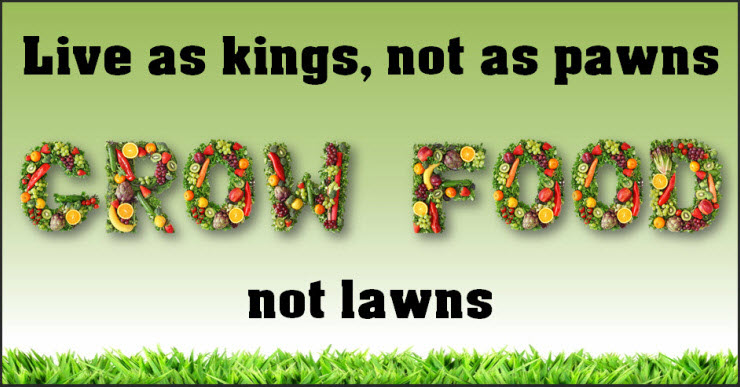July 31st, 2017
Contributing writer for Wake Up World
If you’re anything like me, America’s obsession with ornamental lawns seems nothing short of folly at best, sheer polluting waste at worst. Many are unaware that lawns are one of the largest sources of pollution in the US, with 40 million acres under cultivation, they absorb three million tons of chemical fertilizers and 30,000 tons of pesticides, and use 800 million gallons of gasoline for mowing each year. [source]
And for what? A green patch that serves very little purpose, yet creates staggering pollution. Meanwhile, we have a severe need for more localized food systems and access to affordable produce in neighborhoods throughout the US.
We can complain and fume about this state of affairs — or we can do something about it. Recognizing there had to be a better way, the idea of Fleet Farming was born.
The Problem — And an Innovative Solution
Did you know, here in the US, each meal travels about 1,500 miles from farm to table? Or that, for every calorie we consume, 10 calories of fossil fuel are used? Granted, a good number of us are savvy farmers market shoppers during the summer — and community supported agriculture (CSA) is growing in leaps and bounds. But what if we could develop a system that’s “hyper-local” — where produce for personal consumption, local farmers markets and restaurants is grown within a 5 mile radius? Better yet, where all produce is grown on micro-farms — otherwise known as “farmlettes” — where unproductive, wasteful lawns have been transformed into community-driven farm plots.
What if this was taken one step further, where a bike-powered fleet is used, instead of gasoline-powered vehicles, for all transportation of produce? And fossil fuel consumption is significantly slashed, not only during production and transportation, but also by reducing the emissions from mowing lawns and the use of chemical fertilizers and herbicides. Sound far fetched? Not if your an innovative organization called Fleet Farming in Orlando, Florida.
Farmlette to Table — A New Model of Local Organic Produce
In 2013, John Rife, owner of East End Market, introduced the world to his idea of Fleet Farming at The Hive Orlando, part of the IDEAS For US foundation — a “think and do tank” where citizens can present their solutions for global challenges. Within a couple of months, John and other participants in IDEAS For US refined his concept further.
Then, in February 2014, Fleet Farming launched its pilot program, where the team converted 5 homeowner lawns to farmlettes. By summer of that year, word was out about the program and Fleet Farming was awarded a $5,000 grant for expansion. In January of 2015, they received another $10K in grants from 1% For the Planet and the Cliff Bar Foundation. By August, 15 farmlettes were in production and had sold over $7,000 in produce. Fleet Farming recouped all its start up costs in the very first year — not including a single grant they received.
How Does it Work?
Fleet Farming outlines the requirements for program participants:
“Any landowner (or renter with owner consent), can donate their chemical-free lawn to Fleet Farming. If the area is optimal for growing, we will arrange a site assessment and schedule the installation. Each landowner must sign a 2 year agreement with a suggested donation of $500 to the cover start-up costs (subsidies available for those who qualify). With over 300 lawns donated in our first two years, we have developed a wait-list for the Orlando area and hope to have at least 8 Fleet Farming branches with a total of 200 farmlettes throughout Central Florida neighborhoods by 2020.”
In return, farmlette hosts are allowed to harvest a share of the produce for their own use. While Fleet Farming is responsible for maintaining the plot, hosts are encouraged to take part in the farming process.
Fleet Farming also offers Fleet Fruit Gleaning, where fruit tree owners register their trees for harvesting. Once registered, the owner sends a quick email to Fleet Fruit when the fruit begins to ripen. The team will then come and harvest it, which will then be sold. When all is said and done, the owner receives a tax-deductible receipt in the amount sold for the donated fruit. The owner further benefits by having under harvested fruit removed from their property, thereby avoiding the attraction of pests and rodents due to fallen fruit. The only requirement is that the fruit trees be “chemically untreated and organically nurtured.”
Currently, Fleet Farming and Fruit Gleaning grows and sells a variety of seasonal produce, including:
- Salad greens, like spinach, cranberry hibiscus, baby chard, arugula, leaf broccoli, Scarlet Frill, Mizuna and more.
- Cabbage, collards, three types of kale, mustard greens.
- Beets, carrots, purple top turnips, radishes.
- Borage, cilantro, dill, fennel, two types of parsley, mammoth sunflowers, marigolds, nasturtium.
- Alfalfa, cowpea, okra, lufa, Malabar spinach, morninga, purple sweet potato, seminole pumpkin.
- Avocado, banana, citrus, kumquat, loquat, longan, mango, mulberry, passion fruit, papaya, prickly pear, starfruit.
The organization also offers educational programs.
A one-hour Fleet presentation includes a Power Point talk that gives an in-depth view of how and why this bike-powered urban farming program came into play. Q+A session follows.
The Private Swarm Ride takes place at Audubon Park, Florida and teaches small groups the ins and outs of urban agriculture. Hands-on and designed for scout groups, garden clubs, birthday parties and more, the program includes a walk or bike ride down “Fleet Street”, 30 minute education on why and how to farm, and 1 hour of harvesting, seeding and weeding the fleet farmlettes.
Want to learn more about Fleet Farming and how to get involved? Have a look at their website here.
Recommended articles by Carolanne Wright:
- New Research Links Hand Sanitizer Use With Thyroid Cancer
- Renowned Harvard Psychologist Says ADHD is Largely a Fraud
- Hyperbaric Oxygen Treatment Reverses Fibromyalgia in 70% of Patients, Researchers Find
- Wealth and Social Media Breed Narcissism and Lack of Empathy, Says New Research
- Over 100 Scientific Studies Agree: Cannabis Annihilates Cancer
- If You Care About Animals and the Earth, Here’s Why You Need to Boycott Palm Oil Immediately
- Latest Research on CBD Oil Offers New Hope for Healing Leaky Gut Syndrome and Autoimmune Disorders
- Scientific Breakthrough: Alzheimer’s Ultrasound Therapy Fully Restores Memory Function in Mice
- Why You Should Have a Himalayan Crystal Salt Lamp in Every Room of Your House
- A Glorious Fight Against Food Waste: Supermarket Chain Celebrates “Ugly” Produce — With Stunning Results
- Iceland Taught Kids How to Get Naturally High – And Teenage Substance Abuse Plummeted
- Brain Scans Show Psychedelic Drugs Really Do Spark Heightened States of Consciousness
 Carolanne enthusiastically believes if we want to see change in the world, we need to be the change. As a nutritionist, natural foods chef and wellness coach, Carolanne has encouraged others to embrace a healthy lifestyle of organic living, gratefulness and joyful orientation for over 13 years
Carolanne enthusiastically believes if we want to see change in the world, we need to be the change. As a nutritionist, natural foods chef and wellness coach, Carolanne has encouraged others to embrace a healthy lifestyle of organic living, gratefulness and joyful orientation for over 13 years
Through her website Thrive-Living.net she looks forward to connecting with other like-minded people from around the world who share a similar vision. Follow Carolanne on Facebook, Twitter and Pinterest.
Source Article from https://wakeup-world.com/2017/07/31/astonishing-success-fleet-farming-breaking-new-ground-in-food-not-lawns-movement/
Related posts:
Views: 0
 RSS Feed
RSS Feed















 July 31st, 2017
July 31st, 2017  Awake Goy
Awake Goy 


 Posted in
Posted in  Tags:
Tags: 

















Hi, I just came across your web side and I am so intrigued by using lawns for growing. I live in a low income co op, which is mortgage free. We have lots of green space, which is not treated with chemicals but, we do live across a ravine. We have lots of squirrels, racoons, even deer and I do not know what else comes across our lawns. Would it make sense to look into a project like yours. I am just inquiring about it because something like this would have to be approved by the board. I am looking forward to hearing from you and thank you for it. Enjoy your day. We just had an ice storm over the weekend in southern Ontario/Canada. Sincerely, Baerbel Kirstein